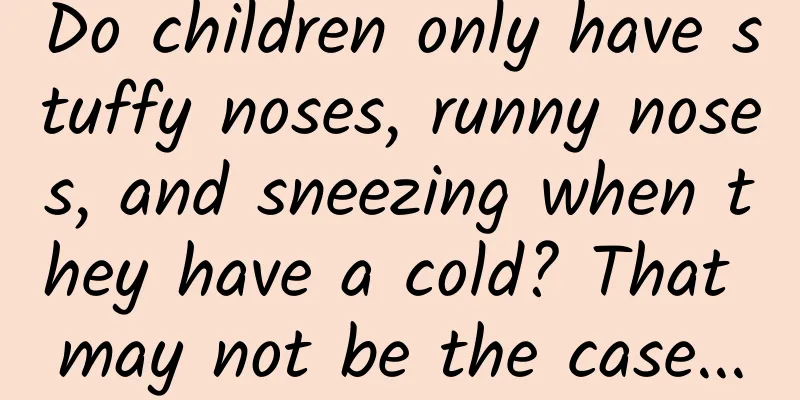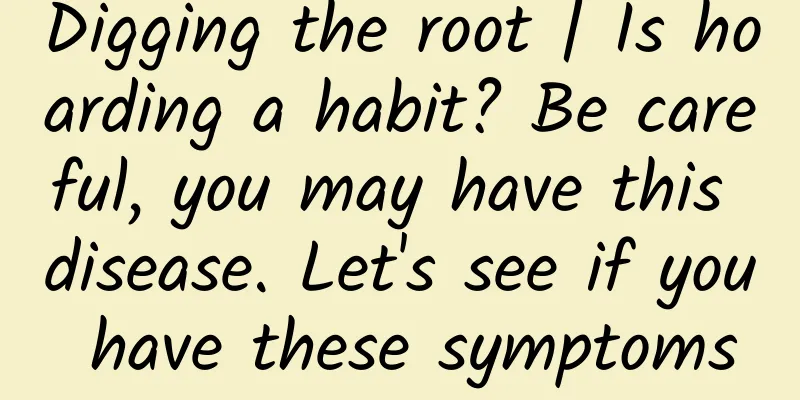Do children only have stuffy noses, runny noses, and sneezing when they have a cold? That may not be the case...

|
gossip In spring, if children repeatedly experience nasal congestion, itchy nose, runny nose, sneezing, etc., it means that the child has a cold. analyze Many people start to have runny noses and coughs in spring, especially children. The symptoms come back over and over again, and many parents think their children have caught a cold. Cold medicine seems to work, but the symptoms get worse after a few days. So some parents say: Our children are weak and always catch colds. Is this really the case? If your child has a runny nose repeatedly, it may be allergic rhinitis! The incidence of allergic rhinitis in children is increasing year by year, and spring is the peak season. However, because its symptoms are atypical and difficult to distinguish from a cold, it is easy to delay diagnosis and treatment. If allergic rhinitis is not controlled for a long time, it will affect the growth and development of children, so we must pay attention to it. So how do we distinguish allergic rhinitis from the common cold, and how can we diagnose it in time? Image source: Copyright Library What is allergic rhinitis? First, let’s take a look at the disease. Allergic rhinitis has a standard definition: a non-infectious chronic inflammatory disease of the nasal mucosa mediated primarily by immunoglobulin E in atopic individuals after exposure to allergens. [1] This definition is very difficult to understand, but it is easy to understand if we break it down. It mainly includes the following points: 1. "Atopic individuals" refer to people with atopic allergic constitutions. Patients with allergic rhinitis themselves have atopic allergic constitutions; 2. Allergic rhinitis occurs due to contact with allergens ; 3. Allergic rhinitis is not caused by bacteria, viruses or other pathogens. It is a non-infectious disease . 4. Allergic rhinitis is chronic, will recur, and cannot be cured ; 5. Immunoglobulin E (IgE) plays a major role in the development of allergic rhinitis. This is not easy to understand, so we can ignore it. It is enough to remember the first four points. What are the symptoms of allergic rhinitis? Allergic rhinitis is not a mysterious disease. Even people who do not have allergic rhinitis have almost personally experienced these symptoms, including: 1 Nasal congestion Unlike the persistent nasal congestion of COVID-19 patients, the nasal congestion of allergic rhinitis has certain patterns, which are often mild and severe, sometimes absent, and even within a day, it may be severe in the morning and completely "good" in the afternoon. If you are allergic to pollen, most of the symptoms occur in spring and are relieved in other seasons. 2 Runny nose The nose will have clear watery mucus. However, if the amount of mucus is small, it will appear as repeated sniffing. The mucus will also flow back into the throat through the posterior nostril, irritating the pharynx and causing symptoms such as repeated throat clearing and coughing. 3 Itchy nose Children often cannot clearly explain the feeling of an itchy nose and may rub or pick their noses repeatedly, or rub their noses against their parents . Adults will also get used to it if their noses itch for a long time and they will not feel it anymore, but will subconsciously stick out their noses and rub their noses . 4 sneeze This often occurs immediately after contact with the allergen, or when sleeping or just getting up in the morning, and is often accompanied by sneezing. Image source: Copyright Library Other symptoms include nose bleeding , and younger children may have very atypical symptoms such as poor appetite and poor sleep . How to distinguish allergic rhinitis from colds? Although the symptoms of allergic rhinitis and cold are very similar, combined with the definition of allergic rhinitis we mentioned earlier, we can understand that the two are essentially different in cause, pathogenesis, duration, etc. It is recommended to distinguish allergic rhinitis from colds from the following points: 1. Check whether the child has atopic allergy and whether there is a family history of allergies As mentioned in the previous definition, children with atopic allergies are more likely to suffer from allergic rhinitis. Parents can find some clues that indicate their children have atopic allergies if they pay more attention and observe more. For example: ▶ History of severe eczema or urticaria in infancy. ▶ Children with a clear history of milk protein allergy or other food allergies, especially those whose mouth area becomes red after eating certain fruits and vegetables, are more likely to develop allergic rhinitis. ▶ Those who are prone to red and itchy eyes, or have a clear history of allergic conjunctivitis. ▶ When you come into contact with allergens such as pollen, dust mites, mold, animal dander, etc., you will immediately have a runny nose and sneeze (this is actually a symptom of allergic rhinitis). ▶ It is also important to know whether the parents have allergic diseases. Allergic constitution is related to genetic factors. If the parents have allergic diseases such as atopic dermatitis, urticaria, allergic rhinitis, asthma, etc., then the probability that the child also has allergic constitution will be much higher. If neither the child nor the parents have atopic allergies, then the child's runny nose or nasal congestion is more likely to be a simple cold. Image source: Copyright Library 2. Look at the child’s age Allergic rhinitis rarely occurs in children under 2 years old, and it is also rare for them to have their first attack in adulthood. Most patients with allergic rhinitis begin to gradually develop symptoms before school age. If not treated, the symptoms will gradually worsen. Therefore, if children under 2 years old have nasal congestion and runny nose, it is more likely to be caused by the common cold or other diseases, and it is less likely to be caused by allergic rhinitis. Children in the preschool and school age groups need to consider the possibility of allergic rhinitis. 3. Look at the characteristics of the symptoms The main symptoms of a cold are sneezing, nasal congestion, runny nose, etc. In addition, there are systemic symptoms such as general discomfort, fever, headache and other symptoms, but nasal itching rarely occurs. Allergic rhinitis not only causes nasal congestion, runny nose, and cough, but also nasal itching. However, systemic symptoms generally do not appear when allergic rhinitis occurs. The runny nose of patients with colds may be clear water, white sticky mucus, or yellow purulent mucus; the runny nose of patients with allergic rhinitis is mostly clear water. Therefore, the symptoms of allergic rhinitis follow certain rules according to their allergens. Colds, however, can occur all year round as long as there are triggers, but are more common in winter and during the transition between seasons. 4. Check the duration of the disease Image source: Reference [2], Translation: Author The course of a cold has a clear trend of change. If accompanied by fever, the fever is most obvious in the first three days of illness, when nasal congestion, runny nose, and cough are not serious. The fever begins to improve after three days, but runny nose, nasal congestion, and cough are most serious on the 3rd to 6th day. After a week, all symptoms begin to improve significantly, and most will be completely cured within two weeks. The symptoms of nasal congestion, runny nose and cough of allergic rhinitis have no obvious changing trend, and are sometimes mild and sometimes severe. The symptoms will worsen when exposed to a large amount of allergens, and will be alleviated when there is no contact with allergens. Allergic rhinitis is a chronic disease related to contact with allergens. Symptoms may recur or last for more than two weeks. Although the symptoms last for a long time, the mental state of children with mild allergic rhinitis is rarely affected. Diagnosis of allergic rhinitis Diagnosis of allergic rhinitis still requires the professional judgment of a doctor. If you suspect your child has allergic rhinitis, it is recommended that you take your child to an ENT department for a doctor's diagnosis. In addition to the nasal congestion, runny nose, and sneezing that are very similar to colds as we mentioned above, if the child always has unexplained nosebleeds, habitually rubs the nose and eyes, sleeps poorly at night, has heavy nasal breathing or even snoring, breathes with open mouth, has obvious dark circles under the eyes, has crooked teeth, etc., parents are also advised to take their children to an ENT department for consultation. The doctor will make a diagnosis based on some of the child's characteristic manifestations↓ ▶ 1. Allergic facial features: such as dark circles, aggravated skin lines and wrinkles on the lower eyelids (i.e. Dennie Morgan lines), transverse wrinkles on the nose caused by repeated upward friction and pushing on the nose tip, open mouth breathing, etc. Image source: Reference [3], Translation: Author ▶ 2. The nasal mucosa is pale, accompanied by swelling of the nasal concha mucosa, and clear nasal discharge is seen in the nasal cavity; ▶ 3. Because of the constant backflow of mucus, the proliferation of lymphatic tissue in the pharynx is stimulated. When the child opens his mouth wide, the doctor can see the proliferation of lymphatic tissue on the posterior pharyngeal wall like pebbles. ▶ 4. If the child has severe nasal mucosal swelling and Eustachian tube dysfunction, using an otoscope to look at the ear may reveal a sunken eardrum or fluid accumulation through the eardrum. Based on various typical symptoms and signs, the doctor can make a clinical diagnosis of whether the child has allergic rhinitis. in conclusion The symptoms of allergic rhinitis are nasal congestion, itchy nose, runny nose, sneezing, and related throat clearing, coughing, poor sleep, poor appetite, etc. Parents can make a preliminary distinction between allergic rhinitis and colds based on whether the child has atopic allergy, the child's age, symptoms, and course of the disease. The diagnosis of allergic rhinitis still requires a professional doctor's diagnosis. References: [1] Rhinology Group of the Editorial Committee of the Chinese Journal of Otorhinolaryngology Head and Neck Surgery, Rhinology Group and Pediatrics Group of the Chinese Society of Otorhinolaryngology Head and Neck Surgery. Guidelines for the diagnosis and treatment of allergic rhinitis in children (2022, revised edition) [J]. Chinese Journal of Otorhinolaryngology Head and Neck Surgery, 2022, 57(4): 392-404. [2]Pappas DE, Hendley JO, Hayden FG, Winther B. Symptom profile of common colds in school-aged children. Pediatr Infect Dis J 2008; 27:8. [3] Allergic rhinitis: clinical manifestations, epidemiology and diagnosis. Uptodate. https://www.uptodate.cn/contents/zh-Hans/allergic-rhinitis-clinical-manifestations-epidemiology-and-diagnosis. Author: Zhang Lujie, deputy chief physician of pediatrics Review | Wang Jianting, Deputy Chief Physician, Department of Otolaryngology, Beijing Chaoyang Hospital, Capital Medical University The article is produced by "Science Refutes Facts" (ID: Science_Facts). Please indicate the source when reprinting. The pictures in this article are from the copyright gallery and are not authorized for reproduction. |
<<: No way, no way, washing your face with pig organs is so clean?
Recommend
A brief discussion on internal scrolling layout
1. What is inner scrolling layout? The so-called ...
Huanwang Technology: Cross-border, smart large-screen investment enters the third stage
Since 2020, the smart large-screen industry has a...
14 self-media publishing platforms and commonly used new media operation tools!
Today, the editor has compiled some tools that yo...
The bonus period of Douyin fans is coming, how can we take advantage of it?
Follow the flow , you will never go wrong. This s...
Law of Attraction Course + Wealth Attraction Course: Perfectly realize your dreams and wishes and make your life rich
Law of Attraction Course + Wealth Attraction Cour...
Apple iOS 13's new features will always give you a refreshing feeling
2019 has passed, and it has been almost a month s...
What should the TV industry do in the future when it is stuck in the quagmire of closed-door development? The mobile phone industry has given the answer
Under heavy pressure, TV manufacturers have resor...
In Praise of the Independent Programmer
[[149946]] Parkinson’s Theorem[1] tells us that “...
Will keeping long hair during pregnancy take away nutrients from the baby? Stop torturing pregnant women...
gossip "Will long hair compete with the baby...
Don’t miss the “golden time” for these 5 things. Breakfast, exercise, and bathing will double your benefits…
Everyone wants to do the right thing at the right...
International Chef Day | Can you finish three bowls of the meal cooked by the chef? Don’t ignore the tricks behind the “delicious” meal!
Tired from school, tired from work, tired after w...
Why do Android devices become stuck after being used for a long time and Apple devices crash after being used for a long time?
Generally, after using a mobile phone for about t...
What are the requirements for opening a Baidu framework account?
It is quite troublesome to open a Baidu account n...
How can cash loan products effectively improve conversion rates under high traffic costs?
To improve conversion rate is to improve user exp...
In the K12 education industry, how to expand into lower-tier cities and acquire customers?
As the concept of sinking begins to penetrate int...






![[Mobile Development Channel] What has changed in WeChat in recent years?](/upload/images/67ebee85debd9.webp)


